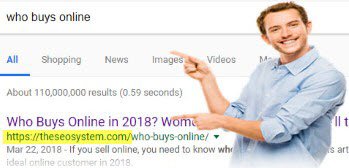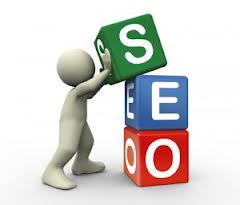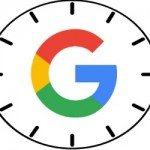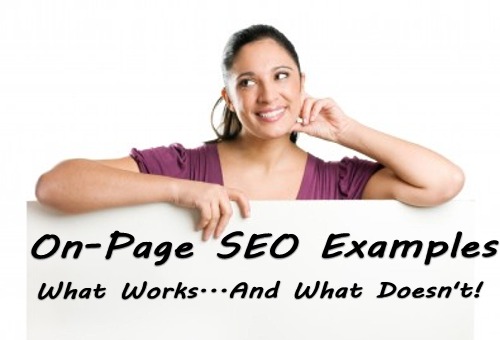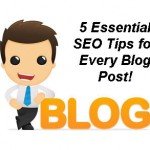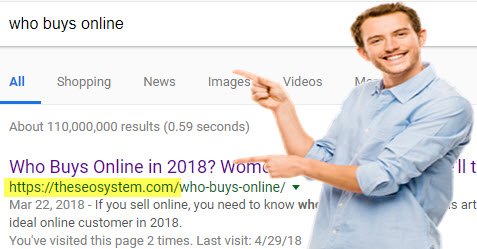 With some quick on-page SEO optimization, you can get to the top of Google using these 7 techniques.
With some quick on-page SEO optimization, you can get to the top of Google using these 7 techniques.
Don’t believe me?
Well, take a look at the picture on the top right of this post. That’s where my page about online buying behavior in 2018 ranks for its key term “Who Buys Online”.
Following the on-page SEO checklist below, you too can achieve similar rankings for terms that are not too competitive.
Why? The answer is simple. The majority of web pages still do not have well-crafted or even basic on-page SEO to rank well within the search engines.
This is extremely important because, while there are many strategies to market your web content, the best (and least expensive) long term solution is for your content to be found by Google searchers.
In other words, you want to achieve the highest possible organic rankings for your article.
This can only be achieved if those fiendish little Google bots know what your content is about.
You must create web content that can be digested not only by humans but by the search bots who catalog your content and, in the end, determine your organic rankings.
It's time to master organic web content marketing through solid on-page SEO. Click To TweetI am going to present 7 questions that need to be properly answered before you publish your web content. This will serve as your 2019 on-page SEO checklist.
If you can answer all 7 satisfactorily, I assure you that you will measurably improve your ranking in the search engines.
Question 1: Have you identified the keywords in your document?
It’s nice to have a great idea, put pen to paper (or fingers to keyboard!), and publish your particular brand of genius to the world.
It’s not so nice when you realize that nobody is reading it. What a waste of effort, you think.
My mom was always a “bottom-line” type of person and, in channeling my upbringing, I will tell you the bottom line about generating organic traffic results from Google and the other search engines:
You have to create web pages that are optimized for terms that people actually use when searching.
This is the the #1 and most important item on our 2019 on-page optimization checklist.
Online marketer Neil Patel recently purchased and continues to improve a tool called Ubersuggest, which I enthusiastically recommend.
Read more about how to choose your keywords here.
Question 2: Have you included these keywords in the title of your document?
The title of your document is what people see in the organic search results and should contain your keywords. Don’t believe me? Let’s do a random test…the first thing that comes to mind:
And the results…
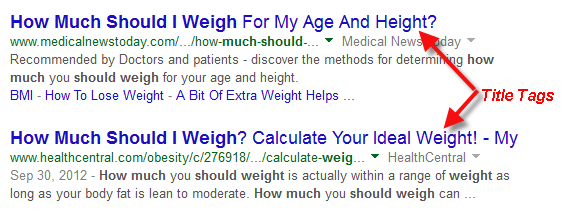
As you can see, the title tag is what Google displays to those searching the web.
Here, you want to use your creative marketing chops by both including the keywords AND creating a title that entices these searchers to click.
Don’t think that’s important? Did you know that 80% of readers actually never make it past the headline?
For further information, check out these 9 Powerful Title Generators That Drastically Increase Click-Thrus!
Question 3: Do these keywords appear in the URL of your document?
Sticking with our weight example above, let’s jump over to the URL (the URL is just the web address) of the first entry. And, lo and behold, the keywords are there as we see below.
![]()
Many web creators do not give much thought to the URL because it’s automatically created. However, you can override this behavior to make sure the URL contains your keywords and is short.
While it’s not the most important component of basic on-page SEO, it can be the differentiator between you and the competition.
If you’d like more information on properly configuring the URLs for your website, I recommend these 8 SEO Tips to Optimize Your URL Structure.
Question 4: Have you used these keywords in heading tags throughout your document?
Heading tags are the items on a web page that appear in larger text and are bold-faced.
Why are heading tags important in our on-page SEO analysis?
The search bots use these as an influencer in ranking your web pages. Thus, need it be said that your keywords should show up within heading tags in your web page?
In our weighty example, here is the h1 tag:
![]()
The next stand-out heading tag is an h2 tag as we see below:
![]()
“So, where are the keywords?” you may ask.
In this example, it is important to note that these little search bots have evolved over the years and now heavily consider keyword synonyms and related keywords.
Thus, you need not have your keywords everywhere and, in fact, you shouldn’t…lest you be seen as a keyword stuffer.
The bottom line here: Use your keywords, synonyms, and related keywords in heading tags. Not only do they improve your organic search positioning, they make your document easier to read.
Question 5: Did you create a compelling meta-description that includes your keywords?
The meta-description tag factors less in the search rankings than in the past but it is still very important in our pursuit of optimal on-page SEO.
Why? Well, once you have achieved organic rankings, you now want people to click what they see in the results. Is your meta-description enticing? If not, people will probably not click it.
And do you know happens if they don’t click it? The new new Google Rankbrain algorithm will realize that people don’t click and it will downgrade your position in the SERPS!
That’s very bad!
So flex that marketing muscle and try to come up with a meta-description that includes your keywords AND is compellingly clickable.
In her informative article Meta Description Magic, Kristi Hines gives several tips for improving search engine result click-throughs. Or, you may want to jump over to this article called The Importance of SEO Meta Descriptions to read more about the value of meta-description as an important part of your on-page SEO checklist.
Question 6: Does your web content include images or videos with the keywords?
In case you have not witnessed this in the past 10 years, people love images and videos in web content. Well, so do the pesky, pugnacious search bots.
Videos also increase “on-page” time (because people spend time watching them) which is another important factor in organic search rankings in 2019. And, with today’s technology, it’s not that difficult to repurpose blog posts for video.
Images and videos allow you to market your existing content to visually minded people AND allow you to add keywords and/or related synonyms to your web content. For example, an image allows you to add keywords both in the name of the image and the “alt” tag representing the image.
Bottom line: Be sure your web content has one or more images and videos related to the article!
Question 7: Do your keywords (and synonyms) appear with sufficient density in the body of your article?
I can’t tell you how many times people have said to me: “Well, look, I used the keyword on the page here!”
“One time,” I invariably respond, “is not enough”.
But just how often should your keywords/synonyms appear on a page? You don’t want to be a page-stuffer or you may be deemed as trying to manipulate the search engines.
However, if you just use the word one time, the bots may not know what your page is about and your on-page SEO efforts will likely be in vein.
What we are talking about is keyword density, an important on-page SEO consideration.
How much is too much and how much is not enough?
The general answer is about 2% density for your chosen keywords. You can use this keyword density checker and I would also advise that you see what the current sites who rank for your chosen keywords are doing.
Conclusion: Performing On-Page SEO Analysis in 2019 to Get to the Top of the SERPs
I have consulted for many companies who constantly beat the “web content marketing” drum.
With the goal being to release blog posts and articles as quickly as possible, they get lost in the trees and can’t see the forest view, the big picture.
After some time, they ask: “Why is our web content not generating visitors and customers?”
To achieve organic web marketing success, you must step back from your content and ask yourself: “Is this web content structured for organic success?”
The 7 questions above will determine that. If you can answer each question confidently, I guarantee that you have implemented sound on-page SEO in 2019 and that your web content is ready for organic success.
Once your page has been properly SEO’d, we invite you to jump over and try our daily online content marketing plan to achieve long-term, consistent results in the search engines.
Richard Cummings
Latest posts by Richard Cummings (see all)
- Indexing Requests Currently Suspended [Google Search Console] - October 15, 2020
- Google Analytics and Google Tag Manager Code:Do I Need Both? - September 19, 2020
- WordPress X Theme:How To Setup Google Tag Manager - September 17, 2020

